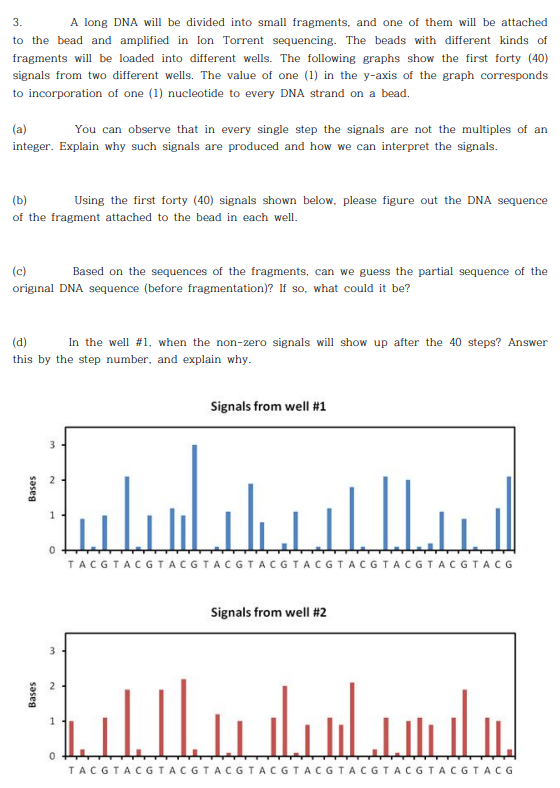3. A long DNA will be divided into small fragments, and one of them will be attached to the bead and amplified in lon Torrent sequencing. The beads with different kinds of fragments will be loaded into different wells. The following graphs show the first forty (40) signals from two different wells. The value of one (1) in the y-axis of the graph corresponds to incorporation of one (1) nucleotide to every DNA strand on a bead. (a) You can observe that in every single step the signals are not the multiples of an integer. Explain why such signals are produced and how we can interpret the signals. (b) Using the first forty (40) signals shown below, please figure out the DNA sequence of the fragment attached to the bead in each well. (c) Based on the sequences of the fragments, can we guess the partial sequence of the original DNA sequence (before fragmentation)? If so, what could it be? (d) In the well #1, when the non-zero signals will show up after the 40 steps? Answer this by the step number, and explain why. Signals from well #1 3 TACGTACGTACGTACGTACGTACGTACGT ACGTACGTAC G Signals from well #2 3 السليسياسيليلل TACGTACGTACGTACGTACGTACGTACGTACGTACGTACG Bases Bases 2.
DNA and RNA
Deoxyribonucleic acid (DNA) is usually called the blueprint of life. Deoxyribose is a monosaccharide that has a key function in the synthesis of deoxyribonucleic acid. One less oxygen-containing hydroxyl group occurs in deoxyribose sugar. Nucleic acid, deoxyribonucleic acid, is one of the natural components. Deoxyribonucleic acid is a double-stranded molecule. Watson and Crick postulated the double-stranded model of the helix. A deoxyribonucleic acid is a molecular group that carries and transmits genetic information from parents to offspring. All eukaryotic and prokaryotic cells are involved.
DNA as the Genetic Material
DNA, or deoxyribonucleic acid, is a long polymeric nucleic acid molecule discovered in the late 1930s. It is a polymer; a long chain-like molecule made up of several monomers connected in a sequence. It possesses certain characteristics that qualify it as a genetic component. Certain organisms have different types of nucleic acids as their genetic material - DNA or RNA.
Genetics
The significant branch in science which involves the study of genes, gene variations, and the organism's heredity is known as genetics. It is also used to study the involvement of a gene or set of genes in the health of an individual and how it prevents several diseases in a human being. Thus, genetics also creates an understanding of various medical conditions.
DNA Replication
The mechanism by which deoxyribonucleic acid (DNA) is capable of producing an exact copy of its own is defined as DNA replication. The DNA molecules utilize a semiconservative method for replication.

Step by step
Solved in 3 steps




